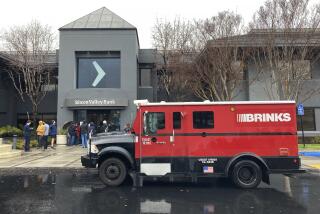As Prices Fall, Farmers Turn to Illegal Cash Crops
On the edge of suburbia here, where farmland awaits the developer’s plow, the magnificent gardens of Southeast Asian refugees rise and fall.
On leased ground no bigger than 5 or 10 acres -- small potatoes to the giant industrial growers -- the refugees plant their own longshot dreams: Chinese bitter melon, Chinese broccoli, Thai chili, ong choy, su choy, daikon and kohlrabi.
The best strawberries in the San Joaquin Valley are grown by a tribe of CIA-trained commandos who fled the highlands of Laos after the Vietnam War. Thai eggplant, slightly spicier than its Armenian cousin, is the specialty of the lowland Lao.
This spring, anticipating another harvest of low prices in the nation’s most productive farm belt, some Southeast Asian niche farmers are planting a new cash crop under the brutal sun: marijuana.
In the past month, Fresno County investigators have busted a half-dozen marijuana fields hidden by borders of cherry tomatoes. A more ideal camouflage crop -- the tomato and the pot plant have similar leaves -- would be hard to find. Nearly 40,000 squat but prolific bushes have been yanked out and set ablaze, an illicit harvest worth $40 million on the streets -- more than last year’s value for cherries or Valencia oranges or sweet corn in Fresno County.
Five lowland Lao refugees have been arrested and charged with cultivating marijuana for sale. The record heat of spring has not only pushed the vineyards and fruit orchards several weeks ahead of their growing cycles but matured the marijuana in half the time.
“This is the earliest in my 23 years as a narc that we’ve taken off so many marijuana plots,” said Lt. Rick Hill of the Fresno County Sheriff’s Department. “Usually, the plots we find are in the mountains, and they’re mostly operated by gangs from Mexico. These new plots are down on the valley floor, and it’s Southeast Asians who are growing them.”
The tips, meanwhile, keep coming in. Last week, sheriff’s deputies found 13 pounds of processed marijuana, $37,000 in cash and night-vision equipment in a house belonging to a lowland Lao. A storage facility rented by the same man produced two rifles, two handguns and 40 pounds of processed marijuana.
“It’s hard to tell if it’s one big operation or several smaller ones,” Hill said. “I’m afraid we’re on the front end of a trend.”
As sheriff’s deputies canvass the truck farms of Fresno County looking for greener-than-green plants, Southeast Asian leaders are complaining that their community is being unfairly singled out. In one news release, the Sheriff’s Department advised landowners leasing property to Southeast Asian farmers to eyeball the rows for cannabis.
The refugees counter that the vast majority of their truck farms are clean and that authorities, by targeting Southeast Asian farms, are making it difficult for future refugees to lease farmland.
“Anyone who reads the local paper has the conception that Southeast Asian farmers grow marijuana,” said Tzexa Cherta Lee, a leading Hmong grower and packer in Fresno County. “Someone even asked me the other day if the white caps we put over the plants to protect them from frost is the Southeast Asian way of hiding the marijuana.”
The busts find lowland and highland Lao pointing a finger at each other.
So far, the illicit plots have belonged to lowland Lao farmers, though sheriff’s deputies recall that Hmong growers were involved in a spate of similar busts in the mid-1990s. As the Hmong do their best to distance themselves from the new wave of plantings, distrust between the two ethnic groups has grown.
“If they want to talk about the Lao and their pot farms, then we can talk about the Hmong and their opium poppies,” said Pooh Phanthadeth, 33, a Laotian grower tending to a vegetable field on the outskirts of Fresno.
“The Hmong harvest opium right in their backyards, and everyone thinks they’re just California poppies decorating the ground.”
If each group of neighbors seems eager to throw a little dirt on the other, the reasons might be traced to an especially difficult path to acceptance here.
The Hmong, a tribe of 18 clans from the Laotian highlands, were slash-and-burn farmers who lived in jungle huts until the CIA recruited them to fight communist forces during the Vietnam War. After suffering high combat mortality rates, the Hmong began resettling in Central California by the tens of thousands in the late 1970s.
For years, tales of their cultural clash, apocryphal and otherwise, have embroidered the narrative of the San Joaquin Valley. Much to their dismay, their stubborn clinging to old ways has become fodder for headlines.
The traditional Hmong funeral, for instance, is a three-day affair, with elders slaughtering a cow on chapel grounds and burning paper money -- enough in at least one case to set a funeral home on fire. When Hmong become sick, the first call generally goes to a shaman who may opt to sacrifice a live animal to chase away evil spirits. Some Hmong marry brides as young as 11 and practice polygamy.
By contrast, the lowland Lao, city dwellers back home, have had a somewhat easier time crossing the cultural divide. But this hasn’t led to economic gain, at least not for the majority.
Twenty-five years after resettlement, both the Hmong and lowland Lao communities still rely heavily on government assistance. While more than half of the second-generation Southeast Asians have gone on to college or well-paying careers here, social workers say, an additional 40% flounder in dead-end jobs or a cycle of gangs and welfare dependency.
“Even though the Hmong started out more culturally backward, they’ve had a greater number of success stories than us,” said Steve Arounsack, a lowland Lao refugee studying for his doctorate in ecology at UC Davis.
“Because of the Hmong’s tight-knit clan structure, there’s a certain amount of cohesion that the lowland Lao don’t have. If a Hmong takes the wrong turn, they pay a price inside the clan.”
For many unskilled refugees who speak no English, the truck farm represents the best shot at escaping poverty. Making the fringe of Fresno bloom, though, is no easy go. The labor is long, and everyone in the family must pitch in. Even barefoot grandmothers in straw hats and rolled-up jeans stand in the muddy irrigation water to plant the rows.
They say with pride that no boss looks over their shoulder when they trudge to the wooden tent in the middle of the field to eat noodles and spicy beef. But at the end of the day, the buyer’s prices are low and they struggle to cover the rent. Just when they think they have mastered the vagaries of soil and climate, it seems, the landowner sells out to a developer. Refugees hop from field to field, tent to tent.
For the uninitiated, the vegetables grown by Southeast Asians can be confounding. The farmers walk into the county agricultural commissioner’s office and confront officials with leafy greens and tubers they have never seen before. They must consult with books to confirm that a Napa cabbage look-alike is su choy or an arrow-leafed water spinach is ong choy.
Each year, the production value of Asian vegetables increases slightly. Last year, farms totaling 1,470 acres produced $10.3 million -- just a sliver of the $4 billion in crops grown by Fresno County.
“For the most part, these guys are legitimate small farmers. Now a handful lured by the big bucks have stepped over the line,” said Dennis Plann, the county’s deputy agricultural commissioner. “I have some concerns about my staff going out to certify a grower and stumbling on a bunch of this marijuana. It could get dangerous.”
Fresno sheriff’s officials agree that only a fraction of Southeast Asian truck farmers are involved in marijuana cultivation, and they have apologized to the refugees for public comments that suggest they are targets. But they warn that the illegal operations and all that they entail -- such as the use of rifles and night-vision gear -- can pose dangers.
Like the vegetables, the marijuana they raise is an unusual breed. Nurtured indoors and conditioned to grow no more than 3 feet tall, the bushy-leafed crop is easy to hide once transplanted. This season’s first surveillance took narcotics officers to a Southeast Asian vegetable farm that stretched out over 40 acres, far bigger than most.
“About 25 acres were cropped, and 15 acres were being used for marijuana,” Hill said. “I had farmers who walked their dogs every day along that property and all they saw was tomatoes.”
Two men and a woman who spoke little English were arrested and charged with cultivating 12,000 illicit plants. As more tips flowed in, a half-dozen other busts came in quick succession.
The news took Hao Khounmeuang, 30, and her family by surprise. She says she has never seen a marijuana plant growing in any field, Lao or otherwise. But she concedes she may have been too busy to notice.
By day, she works in the field alongside her brother and her husband, Pooh Phanthadeth. By night, she helps build surveillance cameras at the Pelco plant in nearby Clovis. During tax season, she puts her accounting skills to work and moonlights at H&R; Block.
“You can’t make it as a small farmer unless you have an outside job,” she said.
Last year, after moving from one small plot to another in search of better soil, she and her husband bought a 20-acre vineyard in southeast Fresno for $200,000.
They promptly tore out eight acres of Thompson seedless grapes that had lost their market due to a raisin glut and planted squash, peppers, cucumbers, tomatoes, basil and three varieties of eggplant.
“This basil right here is extravagant with fish,” Phanthadeth said as he walked the rows. “Over there, we’re planting Chinese eggplant. When it gets hot, the mites start attacking the eggplant with extreme prejudice.
“As you can see,” he said with a grin, “no marijuana.”
*
(BEGIN TEXT OF INFOBOX)
Cash crops
Fresno County authorities recently destroyed marijuana plants worth $40 million. This exceeds the value of many legal crops grown in the county last year.
Fresno County’s top 5 crops...
(In millions)
*--* Grapes $401 Tomatoes $384 Cotton $342 Cattle and calves $264 Poultry $247 Marijuana discovered this spring $40*
*--*
...and other Fresno County crops
*--* Cherries $33 Valencia oranges $32 Sweet corn $30 Pistachios $14 Asian vegetables $10
*--*
*Figures are 2003 totals, except marijuana.
Sources: Fresno County Agricultural Commission; Fresno County Sheriff’s Department
More to Read
Start your day right
Sign up for Essential California for news, features and recommendations from the L.A. Times and beyond in your inbox six days a week.
You may occasionally receive promotional content from the Los Angeles Times.






